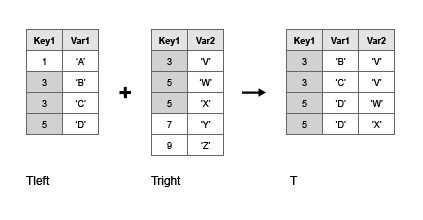innerjoin
两个表或时间表之间的内联
语法
说明
T = innerjoin(Tleft,Tright)Tleft 和 Tright 进行内联,从而创建表或时间表 T。内联会组合那些键变量具有匹配值的行。例如,如果 Tleft 具有名为 Key1 和 Var1 的变量,Tright 具有变量 Key1 和 Var2,则 T=innerjoin(Tleft,Tright) 使用 Key1 作为键变量。

默认情况下,键变量是:
在
Tleft和Tright中具有相同名称的变量,如果两个输入均为表,或如果Tleft是时间表而Tright是表。行时间的向量,如果
Tleft和Tright均为时间表。
左表和右表中键变量的匹配值不必按相同顺序排列。内联可以在两个表的键变量之间执行一对多和多对一匹配。也就是说,在左表的键变量中出现一次的值在右表中可能有多个匹配项。同样,在右表的键变量中出现一次的值在左表中也可能有多个匹配项。
您只能对某些表和时间表组合执行内联。
如果
Tleft是表,则Tright必须是表。innerjoin以表的形式返回T。如果
Tleft是时间表,则Tright可以是表,也可以是时间表。innerjoin以时间表的形式为两种输入组合返回T。
T = innerjoin(Tleft,Tright,Name,Value)Name,Value 对组参量指定的其他选项执行内联运算。
例如,您可以指定要用作键变量的变量。
示例
输入参数
名称-值参数
输出参量
详细信息
算法
来自输入表或时间表的行标签向量可以用作键变量,既可以单独使用,也可以与其他键变量组合使用。行标签是表的行名称或时间表的行时间。要将此向量用作键,请将其指定为
'Row'(如果是表的行名称)、行时间的时间表向量的名称,或者T.Properties.DimensionNames{1}T通常,
innerjoin将行标签从输入表Tleft复制到输出表T。如果
Tleft没有行标签,则T没有行标签。如果
Tleft有行标签,则innerjoin复制Tleft的行标签,以创建T的行标签。但是,如果
Tleft和Tright都是表,而您未将任何输入的行名称指定为键,则innerjoin不会在T中创建行名称。如果
Tleft和Tright均为时间表,但您没有将任一输入的行时间指定为键,则innerjoin会将行时间从Tleft复制到T。
您不能使用
Tleft的行标签作为左键、使用Tright的变量作为右键来执行内联。要执行内联,请将Tleft的行标签转换为表变量,然后使用新的表变量作为键。
扩展功能
版本历史记录
在 R2013b 中推出